Sometime near mid-September, possibly in ceremony at solar noon, the Flathead Electric Cooperative will throw a switch sending 83 kilowatts of A.C. electricity generated at its Stillwater photovoltaic farm north of Kalispell coursing into FEC’s powerlines. The Flathead’s first experiment in community solar (NREL PDF) will have begun.
This isn’t news to most of us in the Flathead. There’s a general description of the project in the May, 2015, issue (PDF) of FEC’s newsletter, Light Reading:
A Community Solar Array, which we have branded “SUN” (Solar Utility Network), will be installed near the Stillwater Substation on Whitefish Stage Road in Kalispell, on property already owned by Flathead Electric.
It will consist of approximately 356 solar panels, which total 100kW of output. Currently, work is being done on the design of the system, along with assessments of various cost components. Soon we will be releasing participation details, but the basic premise is that the Co-op will sell sponsorship of the panels.
Each participating member’s monthly output will be metered and they will receive credit for the pro-rated amount of output on their monthly bill. This enables people to participate in solar energy without the large expense of a complete system at their location. It also works for people who don’t have the proper roof orientation or those with shading issues. Watch for the “SUN” to rise this summer!
But there’s much more information in the coop’s request for proposal (PDF, 14 MB), which is posted on the website of the Bonneville Environmental Foundation.
There’s the project’s construction schedule:
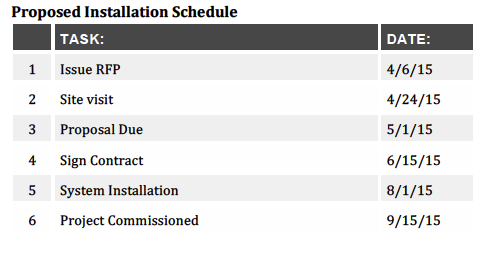
And there’s the description of the south facing, 30-degree tilted, fixed photovoltaic array, which will erected on vacant land at FEC’s Stillwater substation west of the Whitefish Stage Road:

Here’s the RFP’s drawing of the arrays, superimposed on a Google Earth view of the Stillwater substation:
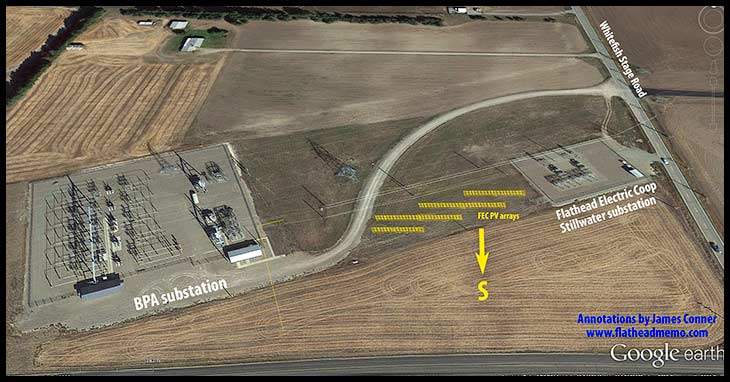
Note that although the project’s advertised output is 100 kilowatts, that’s the direct current value. The AC output that will be fed into FEC’s powerlines is 83 kilowatts, the equivalent of a 110-horsepower diesel engine.
That 83 kW AC output occurs only when the solar rays are pretty much perpendicular to the array, which happens at meridian transit (high noon; download sunrise-sunset-transit-twilight data for the Stillwater site) a month or so on each side of the summer solstice. As the angle of the solar rays diverge from the normal, the array’s output diminishes as a function of the cosine of the angle of incidence.
For example, at 1800 MDT today, the Sun’s altitude will be 33° and its azimuth 269°. The solar angle of incidence for the FEC array would be 61°, the cosine of which is .48. That effect of geometry cuts the output in half. A tracking array can keep the angle of incidence at or near zero, but tracking arrays are more expensive and less reliable than fixed arrays.
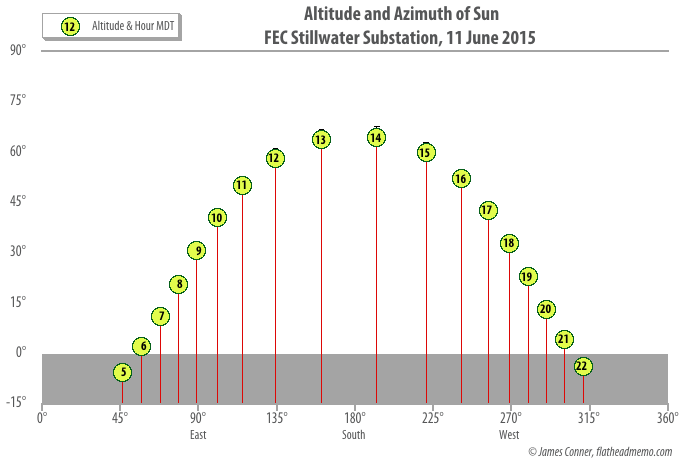
Here are today’s cosine values for the angle of incidence as a function of time:
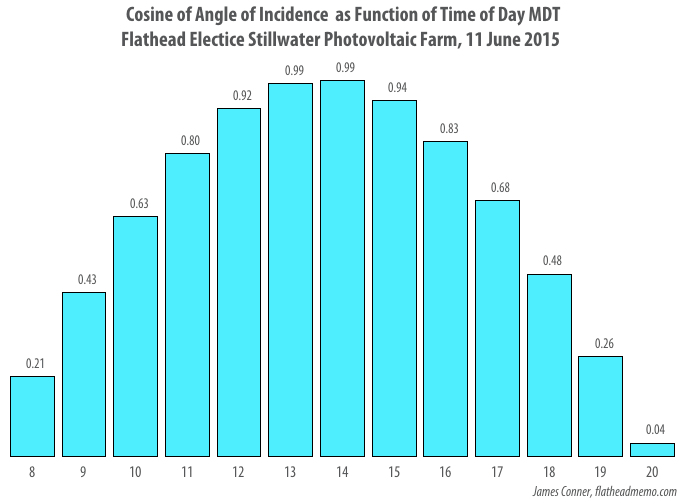
Multiply the cosine values in the column chart above to obtain the percent of square to the panel power for the time of day.
A second set of solar losses occurs as the Sun’s altitude decreases and the solar rays must pass through more atmospheric masses:
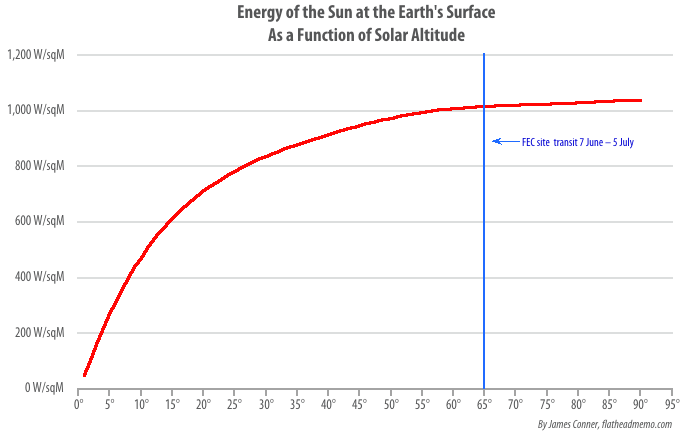
At 1800 MDT today, the solar energy reaching the Earth’s surface at the FEC Stillwater site will be approximately 860 watts per square meter, assuming a perfectly clear atmosphere. The output of the PV panels specified in the RFP is rated at 1,000 watts per square meter. Multiplying the .86 atmospheric extinction factor by the angle of incidence loss of .48 yields a .41 panel output factor for 1800 MDT today. That’s an A.C. output of 34 kilowatts.
Although tracking arrays can keep the angle of incidence near zero for most of the day, the loss of solar energy to the atmosphere as the Sun approaches the horizon cannot be mitigated.
Thus, although the array’s nominal installed capacity is 83 kilowatts, the actual installed capacity is lower, often considerably lower. Flathead Electric should publish a table and/or graphs displaying how the solar geometries described above will constrain the output of the Stillwater array on an hourly and seasonal basis.
The output can be modeled by the National Renewable Energy Laboratory’s System Advisory Module that takes into account not just the geometries just described, but also losses from panel degradation, dirt, reflection, and weather (using data from the U.S. Weather Services’s station at Glacier Park International Airport). When I ran FEC’s array through SAM, it returned very low outputs for November through February, hardly an unexpected finding. Those are cloudy months with the Sun’s altitude below 30° even at high noon. That’s why FEC is tilting the array at 30° instead of the array’s latitude of 48.3 degrees. The shallower tilt optimizes the array for spring, summer, and fall.
I suspect that even with tax rebates and the 280-watt panels specified in the RFP selling for around a dollar a watt, there'll be a long payback time for this project. Keep an eye on the final cost per installed watt. Given FEC already owns the land, this will be a gold-plated project if it comes in for much more than three dollars a watt (installed price of PV systems 1998–2013, PDF 3 MB).Community solar does provide a way for people to invest in photovoltaic energy without putting photovoltaic panels on their roofs. There are several solar gardens in Seattle for example. But communal arrays do not necessarily save investors money in the same way that net metering a homeowner’s array can. And a community solar garden such as this one can provide a utility with an alternative to net metering, a practice no utility loves.
How much economic sense FEC’s Stillwater PV farm makes remains to be seen. It has to make some sense, otherwise FEC’s board would not have approved the project.
I hope FEC is generous with information about this adventure, sharing technical and economic details with the public, and perhaps putting on its website realtime information, which is what Seattle is doing.